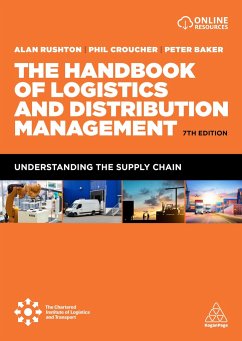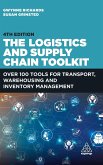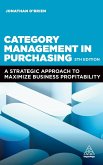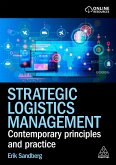Alan Rushton, Phil Croucher, Peter Baker
Handbook of Logistics and Distribution Management
Understanding the Supply Chain
Alan Rushton, Phil Croucher, Peter Baker
Handbook of Logistics and Distribution Management
Understanding the Supply Chain
- Gebundenes Buch
- Merkliste
- Auf die Merkliste
- Bewerten Bewerten
- Teilen
- Produkt teilen
- Produkterinnerung
- Produkterinnerung
Examine all the key aspects of distribution, logistics and supply chain planning and management with this comprehensive, best-selling guide.
Andere Kunden interessierten sich auch für
![Warehouse Management Warehouse Management]() Gwynne RichardsWarehouse Management188,99 €
Gwynne RichardsWarehouse Management188,99 €![Logistics and Supply Chain Toolkit Logistics and Supply Chain Toolkit]() Gwynne RichardsLogistics and Supply Chain Toolkit167,99 €
Gwynne RichardsLogistics and Supply Chain Toolkit167,99 €![Supplier Relationship Management Supplier Relationship Management]() Jonathan O'BrienSupplier Relationship Management183,99 €
Jonathan O'BrienSupplier Relationship Management183,99 €![Category Management in Purchasing Category Management in Purchasing]() Jonathan O'BrienCategory Management in Purchasing184,99 €
Jonathan O'BrienCategory Management in Purchasing184,99 €![Mastering the Circular Economy Mastering the Circular Economy]() Ed WeenkMastering the Circular Economy172,99 €
Ed WeenkMastering the Circular Economy172,99 €![Strategic Logistics Management Strategic Logistics Management]() Erik SandbergStrategic Logistics Management144,99 €
Erik SandbergStrategic Logistics Management144,99 €![Nachhaltige Innovation in Produktion und Logistik Nachhaltige Innovation in Produktion und Logistik]() Nachhaltige Innovation in Produktion und Logistik49,95 €
Nachhaltige Innovation in Produktion und Logistik49,95 €-
-
-
Examine all the key aspects of distribution, logistics and supply chain planning and management with this comprehensive, best-selling guide.
Produktdetails
- Produktdetails
- Verlag: Kogan Page / Kogan Page Ltd
- Seitenzahl: 824
- Erscheinungstermin: 3. Januar 2022
- Englisch
- Abmessung: 250mm x 175mm x 57mm
- Gewicht: 2258g
- ISBN-13: 9781398602069
- ISBN-10: 139860206X
- Artikelnr.: 61964844
- Herstellerkennzeichnung
- Libri GmbH
- Europaallee 1
- 36244 Bad Hersfeld
- gpsr@libri.de
- Verlag: Kogan Page / Kogan Page Ltd
- Seitenzahl: 824
- Erscheinungstermin: 3. Januar 2022
- Englisch
- Abmessung: 250mm x 175mm x 57mm
- Gewicht: 2258g
- ISBN-13: 9781398602069
- ISBN-10: 139860206X
- Artikelnr.: 61964844
- Herstellerkennzeichnung
- Libri GmbH
- Europaallee 1
- 36244 Bad Hersfeld
- gpsr@libri.de
Alan Rushton worked in the chemical industry and is a former Director of Dialog Consultants. He was the Director of Graduate Programmes at the Centre for Logistics and Supply Chain Management at Cranfield University. Phil Croucher held several senior posts in industry, across many countries. He is an independent supply chain consultant and lecturer, and has an MSc in Logistics and Distribution Management from Cranfield University. Peter Baker worked in international freight forwarding and then as a consultant completing over 80 supply chain projects across the world. He was a senior logistics lecturer and, more recently a Visiting Fellow, at Cranfield University.
Section
ONE: Concepts of Logistics and Distribution; Chapter
01: Introduction to Logistics and Distribution; Chapter
02: Integrated Logistics and the Supply Chain; Chapter
03: Customer Service and Logistics; Chapter
04: Channels of Distribution; Chapter
05: Key Issues and Challenges for Logistics; Section
TWO: Planning for Logistics; Chapter
06: Planning Framework for Logistics; Chapter
07: Logistics Processes; Chapter
08: Supply Chain Segmentation; Chapter
09: Logistics Costs and Trade
Offs; Chapter
10: Logistics Network Planning; Chapter
11: Logistics Management and Organisation; Chapter
12: Omnichannel Fulfilment; Chapter
13: Manufacturing Logistics; Section
THREE: Procurement, Inventory and Demand Forecasting; Chapter
14: Procurement and Supply; Chapter
15: Inventory
The Basic Concepts; Chapter
16: Inventory and the Supply Chain; Chapter
17: Inventory Planning and Demand Forecasting; Section
FOUR: Warehousing and Storage; Chapter
18: Principles of Warehousing; Chapter
19: Storage and Handling Systems (Palletised); Chapter
20: Storage and Handling Systems (Non
Palletised); Chapter
21: Order Picking and Packing; Chapter
22: Receiving and Despatch; Chapter
23: Warehouse Design; Chapter
24: Warehouse Management and Information; Section
FIVE: Freight Transport; Chapter
25: International Logistics
Modal Choice; Chapter
26: Maritime Transport; Chapter
27: Air Transport; Chapter
28: Rail and Intermodal Transport; Chapter
29: Road Freight Transport
Vehicle Selection; Chapter
30: Road Freight Transport
Vehicle Costing; Chapter
31: Road Freight Transport
Planning and Resourcing; Chapter
32: Road Freight Transport
Vehicle Routeing & Scheduling; Chapter
33: International Freight Forwarding; Section
SIX: Outsourcing Logistics; Chapter
34: Outsourcing
Operations & Services; Chapter
35: Outsourcing
Decision Criteria; Chapter
36: Outsourcing
The Selection Process; Chapter
37: Outsourcing Management; Section
SEVEN: Operational Management; Chapter
38: Cost and Performance Monitoring; Chapter
39: Benchmarking; Chapter
40: Information and Communication Technology in the Supply Chain; Chapter
41: Security and Safety; Chapter
42: Logistics and the Environment; Chapter
43: Humanitarian Logistics
ONE: Concepts of Logistics and Distribution; Chapter
01: Introduction to Logistics and Distribution; Chapter
02: Integrated Logistics and the Supply Chain; Chapter
03: Customer Service and Logistics; Chapter
04: Channels of Distribution; Chapter
05: Key Issues and Challenges for Logistics; Section
TWO: Planning for Logistics; Chapter
06: Planning Framework for Logistics; Chapter
07: Logistics Processes; Chapter
08: Supply Chain Segmentation; Chapter
09: Logistics Costs and Trade
Offs; Chapter
10: Logistics Network Planning; Chapter
11: Logistics Management and Organisation; Chapter
12: Omnichannel Fulfilment; Chapter
13: Manufacturing Logistics; Section
THREE: Procurement, Inventory and Demand Forecasting; Chapter
14: Procurement and Supply; Chapter
15: Inventory
The Basic Concepts; Chapter
16: Inventory and the Supply Chain; Chapter
17: Inventory Planning and Demand Forecasting; Section
FOUR: Warehousing and Storage; Chapter
18: Principles of Warehousing; Chapter
19: Storage and Handling Systems (Palletised); Chapter
20: Storage and Handling Systems (Non
Palletised); Chapter
21: Order Picking and Packing; Chapter
22: Receiving and Despatch; Chapter
23: Warehouse Design; Chapter
24: Warehouse Management and Information; Section
FIVE: Freight Transport; Chapter
25: International Logistics
Modal Choice; Chapter
26: Maritime Transport; Chapter
27: Air Transport; Chapter
28: Rail and Intermodal Transport; Chapter
29: Road Freight Transport
Vehicle Selection; Chapter
30: Road Freight Transport
Vehicle Costing; Chapter
31: Road Freight Transport
Planning and Resourcing; Chapter
32: Road Freight Transport
Vehicle Routeing & Scheduling; Chapter
33: International Freight Forwarding; Section
SIX: Outsourcing Logistics; Chapter
34: Outsourcing
Operations & Services; Chapter
35: Outsourcing
Decision Criteria; Chapter
36: Outsourcing
The Selection Process; Chapter
37: Outsourcing Management; Section
SEVEN: Operational Management; Chapter
38: Cost and Performance Monitoring; Chapter
39: Benchmarking; Chapter
40: Information and Communication Technology in the Supply Chain; Chapter
41: Security and Safety; Chapter
42: Logistics and the Environment; Chapter
43: Humanitarian Logistics
- Section - ONE: Concepts of Logistics and Distribution;
- Chapter - 01: Introduction to Logistics and Distribution;
- Chapter - 02: Integrated Logistics and the Supply Chain;
- Chapter - 03: Customer Service and Logistics;
- Chapter - 04: Channels of Distribution;
- Chapter - 05: Key Issues and Challenges for Logistics;
- Section - TWO: Planning for Logistics;
- Chapter - 06: Planning Framework for Logistics;
- Chapter - 07: Logistics Processes;
- Chapter - 08: Supply Chain Segmentation;
- Chapter - 09: Logistics Costs and Trade-Offs;
- Chapter - 10: Logistics Network Planning;
- Chapter - 11: Logistics Management and Organisation;
- Chapter - 12: Omnichannel Fulfilment;
- Chapter - 13: Manufacturing Logistics;
- Section - THREE: Procurement, Inventory and Demand Forecasting;
- Chapter - 14: Procurement and Supply;
- Chapter - 15: Inventory - The Basic Concepts;
- Chapter - 16: Inventory and the Supply Chain;
- Chapter - 17: Inventory Planning and Demand Forecasting;
- Section - FOUR: Warehousing and Storage;
- Chapter - 18: Principles of Warehousing;
- Chapter - 19: Storage and Handling Systems (Palletised);
- Chapter - 20: Storage and Handling Systems (Non-Palletised);
- Chapter - 21: Order Picking and Packing;
- Chapter - 22: Receiving and Despatch;
- Chapter - 23: Warehouse Design;
- Chapter - 24: Warehouse Management and Information;
- Section - FIVE: Freight Transport;
- Chapter - 25: International Logistics - Modal Choice;
- Chapter - 26: Maritime Transport;
- Chapter - 27: Air Transport;
- Chapter - 28: Rail and Intermodal Transport;
- Chapter - 29: Road Freight Transport - Vehicle Selection;
- Chapter - 30: Road Freight Transport - Vehicle Costing;
- Chapter - 31: Road Freight Transport - Planning and Resourcing;
- Chapter - 32: Road Freight Transport - Vehicle Routeing & Scheduling;
- Chapter - 33: International Freight Forwarding;
- Section - SIX: Outsourcing Logistics;
- Chapter - 34: Outsourcing - Operations & Services;
- Chapter - 35: Outsourcing - Decision Criteria;
- Chapter - 36: Outsourcing - The Selection Process;
- Chapter - 37: Outsourcing Management;
- Section - SEVEN: Operational Management;
- Chapter - 38: Cost and Performance Monitoring;
- Chapter - 39: Benchmarking;
- Chapter - 40: Information and Communication Technology in the Supply Chain;
- Chapter - 41: Security and Safety;
- Chapter - 42: Logistics and the Environment;
- Chapter - 43: Humanitarian Logistics
Section
ONE: Concepts of Logistics and Distribution; Chapter
01: Introduction to Logistics and Distribution; Chapter
02: Integrated Logistics and the Supply Chain; Chapter
03: Customer Service and Logistics; Chapter
04: Channels of Distribution; Chapter
05: Key Issues and Challenges for Logistics; Section
TWO: Planning for Logistics; Chapter
06: Planning Framework for Logistics; Chapter
07: Logistics Processes; Chapter
08: Supply Chain Segmentation; Chapter
09: Logistics Costs and Trade
Offs; Chapter
10: Logistics Network Planning; Chapter
11: Logistics Management and Organisation; Chapter
12: Omnichannel Fulfilment; Chapter
13: Manufacturing Logistics; Section
THREE: Procurement, Inventory and Demand Forecasting; Chapter
14: Procurement and Supply; Chapter
15: Inventory
The Basic Concepts; Chapter
16: Inventory and the Supply Chain; Chapter
17: Inventory Planning and Demand Forecasting; Section
FOUR: Warehousing and Storage; Chapter
18: Principles of Warehousing; Chapter
19: Storage and Handling Systems (Palletised); Chapter
20: Storage and Handling Systems (Non
Palletised); Chapter
21: Order Picking and Packing; Chapter
22: Receiving and Despatch; Chapter
23: Warehouse Design; Chapter
24: Warehouse Management and Information; Section
FIVE: Freight Transport; Chapter
25: International Logistics
Modal Choice; Chapter
26: Maritime Transport; Chapter
27: Air Transport; Chapter
28: Rail and Intermodal Transport; Chapter
29: Road Freight Transport
Vehicle Selection; Chapter
30: Road Freight Transport
Vehicle Costing; Chapter
31: Road Freight Transport
Planning and Resourcing; Chapter
32: Road Freight Transport
Vehicle Routeing & Scheduling; Chapter
33: International Freight Forwarding; Section
SIX: Outsourcing Logistics; Chapter
34: Outsourcing
Operations & Services; Chapter
35: Outsourcing
Decision Criteria; Chapter
36: Outsourcing
The Selection Process; Chapter
37: Outsourcing Management; Section
SEVEN: Operational Management; Chapter
38: Cost and Performance Monitoring; Chapter
39: Benchmarking; Chapter
40: Information and Communication Technology in the Supply Chain; Chapter
41: Security and Safety; Chapter
42: Logistics and the Environment; Chapter
43: Humanitarian Logistics
ONE: Concepts of Logistics and Distribution; Chapter
01: Introduction to Logistics and Distribution; Chapter
02: Integrated Logistics and the Supply Chain; Chapter
03: Customer Service and Logistics; Chapter
04: Channels of Distribution; Chapter
05: Key Issues and Challenges for Logistics; Section
TWO: Planning for Logistics; Chapter
06: Planning Framework for Logistics; Chapter
07: Logistics Processes; Chapter
08: Supply Chain Segmentation; Chapter
09: Logistics Costs and Trade
Offs; Chapter
10: Logistics Network Planning; Chapter
11: Logistics Management and Organisation; Chapter
12: Omnichannel Fulfilment; Chapter
13: Manufacturing Logistics; Section
THREE: Procurement, Inventory and Demand Forecasting; Chapter
14: Procurement and Supply; Chapter
15: Inventory
The Basic Concepts; Chapter
16: Inventory and the Supply Chain; Chapter
17: Inventory Planning and Demand Forecasting; Section
FOUR: Warehousing and Storage; Chapter
18: Principles of Warehousing; Chapter
19: Storage and Handling Systems (Palletised); Chapter
20: Storage and Handling Systems (Non
Palletised); Chapter
21: Order Picking and Packing; Chapter
22: Receiving and Despatch; Chapter
23: Warehouse Design; Chapter
24: Warehouse Management and Information; Section
FIVE: Freight Transport; Chapter
25: International Logistics
Modal Choice; Chapter
26: Maritime Transport; Chapter
27: Air Transport; Chapter
28: Rail and Intermodal Transport; Chapter
29: Road Freight Transport
Vehicle Selection; Chapter
30: Road Freight Transport
Vehicle Costing; Chapter
31: Road Freight Transport
Planning and Resourcing; Chapter
32: Road Freight Transport
Vehicle Routeing & Scheduling; Chapter
33: International Freight Forwarding; Section
SIX: Outsourcing Logistics; Chapter
34: Outsourcing
Operations & Services; Chapter
35: Outsourcing
Decision Criteria; Chapter
36: Outsourcing
The Selection Process; Chapter
37: Outsourcing Management; Section
SEVEN: Operational Management; Chapter
38: Cost and Performance Monitoring; Chapter
39: Benchmarking; Chapter
40: Information and Communication Technology in the Supply Chain; Chapter
41: Security and Safety; Chapter
42: Logistics and the Environment; Chapter
43: Humanitarian Logistics
- Section - ONE: Concepts of Logistics and Distribution;
- Chapter - 01: Introduction to Logistics and Distribution;
- Chapter - 02: Integrated Logistics and the Supply Chain;
- Chapter - 03: Customer Service and Logistics;
- Chapter - 04: Channels of Distribution;
- Chapter - 05: Key Issues and Challenges for Logistics;
- Section - TWO: Planning for Logistics;
- Chapter - 06: Planning Framework for Logistics;
- Chapter - 07: Logistics Processes;
- Chapter - 08: Supply Chain Segmentation;
- Chapter - 09: Logistics Costs and Trade-Offs;
- Chapter - 10: Logistics Network Planning;
- Chapter - 11: Logistics Management and Organisation;
- Chapter - 12: Omnichannel Fulfilment;
- Chapter - 13: Manufacturing Logistics;
- Section - THREE: Procurement, Inventory and Demand Forecasting;
- Chapter - 14: Procurement and Supply;
- Chapter - 15: Inventory - The Basic Concepts;
- Chapter - 16: Inventory and the Supply Chain;
- Chapter - 17: Inventory Planning and Demand Forecasting;
- Section - FOUR: Warehousing and Storage;
- Chapter - 18: Principles of Warehousing;
- Chapter - 19: Storage and Handling Systems (Palletised);
- Chapter - 20: Storage and Handling Systems (Non-Palletised);
- Chapter - 21: Order Picking and Packing;
- Chapter - 22: Receiving and Despatch;
- Chapter - 23: Warehouse Design;
- Chapter - 24: Warehouse Management and Information;
- Section - FIVE: Freight Transport;
- Chapter - 25: International Logistics - Modal Choice;
- Chapter - 26: Maritime Transport;
- Chapter - 27: Air Transport;
- Chapter - 28: Rail and Intermodal Transport;
- Chapter - 29: Road Freight Transport - Vehicle Selection;
- Chapter - 30: Road Freight Transport - Vehicle Costing;
- Chapter - 31: Road Freight Transport - Planning and Resourcing;
- Chapter - 32: Road Freight Transport - Vehicle Routeing & Scheduling;
- Chapter - 33: International Freight Forwarding;
- Section - SIX: Outsourcing Logistics;
- Chapter - 34: Outsourcing - Operations & Services;
- Chapter - 35: Outsourcing - Decision Criteria;
- Chapter - 36: Outsourcing - The Selection Process;
- Chapter - 37: Outsourcing Management;
- Section - SEVEN: Operational Management;
- Chapter - 38: Cost and Performance Monitoring;
- Chapter - 39: Benchmarking;
- Chapter - 40: Information and Communication Technology in the Supply Chain;
- Chapter - 41: Security and Safety;
- Chapter - 42: Logistics and the Environment;
- Chapter - 43: Humanitarian Logistics
"An impressive book covering the key aspects and processes of logistics and distribution in a detailed and holistic manner. It is an essential read for undergraduate and postgraduate students and others keen to understand more about logistics and distribution." Professor Michael Bourlakis, Director of the Centre for Logistics, Procurement & Supply Chain Management, Cranfield School of Management, Cranfield University








